| Starting
in San Diego and then branching to Orlando (for Disney);
from
1994 to 2010, the ARIA Film Lab
has been known as the place to get the
highest quality ACCELERATED training for professional work in the
motion picture industry. The reason is, it was primarily engineered as
"on the job training" for actual working (shoot in progress) crews and
actors. There has also been spinoff training for support to related
industries, such as effects, makeup, and props. |
|
The Film Labs are comprised of
the following departments:
- The ARIA Film Lab For Crew
- The ARIA Film Lab For On Screen
Actor Training
- The ARIA Stunt School
- The ARIA Film Lab For Youth
|
One-day clinics are also given
for:
- Proper Industry Headshot and Resume
Formats
- Casting Session Do's and Don'ts
- How To Get Started In The Motion
Picture Industry
- So What Is The Stunt World Really
Like?
|
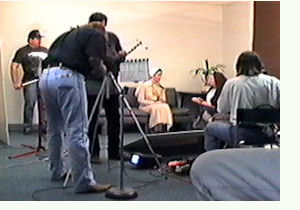 All
of these classes (or schools) were given in San Diego, and the Stunt
School even had a "ranch", where dedicated high fall platforms and
landing areas were setup full time; shooting range for weapon safety
(tough as real, even though blanks are used in production - gun safety
is the same), and even a vehicle stunt training program (cars, trucks,
motorcycles, PWC, and boats). Then production made a shift to Florida
and the bulk of the training relocated there, but clinics remained in
San Diego, with the potential for week long seminars. In Florida, the
program a full class For Youth in 2008, for the purpose of training
child actors for film and television work with Disney. This lead to a
limited general production clinic For Youth in 2010, for the purpose of
trained "actors" to get oriented to set work (established stage
actors). In 2011, classes were suspended for a complete relocation of
both production and training into the Caribbean. All
of these classes (or schools) were given in San Diego, and the Stunt
School even had a "ranch", where dedicated high fall platforms and
landing areas were setup full time; shooting range for weapon safety
(tough as real, even though blanks are used in production - gun safety
is the same), and even a vehicle stunt training program (cars, trucks,
motorcycles, PWC, and boats). Then production made a shift to Florida
and the bulk of the training relocated there, but clinics remained in
San Diego, with the potential for week long seminars. In Florida, the
program a full class For Youth in 2008, for the purpose of training
child actors for film and television work with Disney. This lead to a
limited general production clinic For Youth in 2010, for the purpose of
trained "actors" to get oriented to set work (established stage
actors). In 2011, classes were suspended for a complete relocation of
both production and training into the Caribbean.
At
this point in time, the entire school is packed up for relocation, with
the head instructors searching for the best point in the Caribbean to
begin production and re-initiate training, based on production demands.
Once in the new location, all listed classes may be offered for the
development of movie making operations in the Caribbean. An added note
here, for those who may have been tracking progress, originally the
entire production and training operations were slated for relocation to
Grenada, but following a change in the head of state with the election
of Keith Mitchell as Prime Minister, the new Grenada government has
decided to devote attention to computer based technologies, as a new
"national product". We wish them well in that endeavor. Under the
former Prime Minister, ARIA was to relocate there and form a full sized
production facility, feature film and television production, as well as
the associated training, bringing about 1500 production associated jobs
to Grenada, and a new export industry - a project originally started by
invitation of the former Organisation of Eastern Caribbean States
(OECS) Film Task-force, under the direction of Mr. Sobers Esprit.
If
you are a potential student for one of these classes, please do not
contact ARIA at this time. Class gear and instructors are still "in
transit", and due to the fact that a final location is still in
question, this process may still take several months to complete. Once
things are in place, then word will be spread, and this site will
reflect added scheduling data currently that is removed. Continue
reading on this page for more detailed descriptions of each of the
classes offered by the Film Lab when they resume... |

| These are the four ARIA Film Labs: |
These are "CLINICS": |
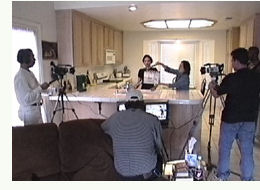 The ARIA Film
Lab For Crew...
was the first training class ever offered under
the ARIA
Film Lab label. It's original intent was NOT NOT NOT to create a
commercial training school, offered to the public for training, but to
train new production crew specifically for ARIA's own production
operations. With this program design, new crew "worked" as interns, and
had added training time on the side, until such time as they were
employable. Problem was, our training was SO GOOD, that our graduates
were immediately called up to Hollywood by larger productions
(producers associated with Paramount, Miramax, Lionsgate and so on),
and we had to start over with a new group. Because this kept happening
over and over, in later cases, students were eventually charged for
admission into the program, but we actually turned those fees into
project budgets, and new shows were developed with crews already
attached. This meant students stayed, as they were attached to existing
shows. Crews got training, and ended up getting immediate work credits
for the new shows created. Unfortunately, due to massive TV show
competition, the bulk of these were never syndicated. In the upcoming
Caribbean version of this training, the first class(es) will initially
have more structure, as some crews must first be trained before any
shows can be put on schedule for production. However, once a few key
crew personnel are ready for field training, then some small projects
will be mobilized and the second stage of training will begin. This is
when the crew training becomes more like the well known "on the job
training" version of the program. The ARIA Film
Lab For Crew...
was the first training class ever offered under
the ARIA
Film Lab label. It's original intent was NOT NOT NOT to create a
commercial training school, offered to the public for training, but to
train new production crew specifically for ARIA's own production
operations. With this program design, new crew "worked" as interns, and
had added training time on the side, until such time as they were
employable. Problem was, our training was SO GOOD, that our graduates
were immediately called up to Hollywood by larger productions
(producers associated with Paramount, Miramax, Lionsgate and so on),
and we had to start over with a new group. Because this kept happening
over and over, in later cases, students were eventually charged for
admission into the program, but we actually turned those fees into
project budgets, and new shows were developed with crews already
attached. This meant students stayed, as they were attached to existing
shows. Crews got training, and ended up getting immediate work credits
for the new shows created. Unfortunately, due to massive TV show
competition, the bulk of these were never syndicated. In the upcoming
Caribbean version of this training, the first class(es) will initially
have more structure, as some crews must first be trained before any
shows can be put on schedule for production. However, once a few key
crew personnel are ready for field training, then some small projects
will be mobilized and the second stage of training will begin. This is
when the crew training becomes more like the well known "on the job
training" version of the program.
|
Proper Industry Headshot and
Resume Formats...
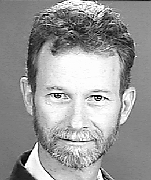
This
is a three hour class normally taught by Chase Jazzborne. The reason
for this is due to Chase actually working with members of the Casting
Society of America (seen as "CSA" in film credits). The details he
learned from the CSA were extensive, as it was his mission then to
bring back to San Diego, all the locals would need to look as
professional as the most seasoned Hollywood actor - at least in print.
Another benefit to Chase conducting these workshops, is that he is an
ultra experienced photographer, and the aspects of shot angles,
backgrounds and crops is best taught by a seasoned photographer who can
translate these details to the general public. |
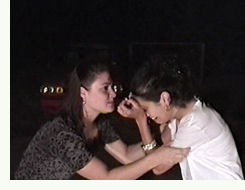 The ARIA Film
Lab For On Screen Actor Training...
was initiated when ARIA was assisting another production company in the
casting of a horror feature ("Evil Dead - Terror In The Wood"). A few
minor character roles, and the leading role for a young girl was
proving very hard to cast from talent sent down from Los Angeles, at
that time. Local San Diego screen talent was not all that skilled
either, at the time. So, ARIA's President (Chase Jazzborne), who was
known for excellent actor training in theater arts, put himself to the
task of creating an accelerated actor training program specifically for
screen. This program - The ARIA Film Lab - was the result. It
also boasted one of the highest professional actor placements of any
program in existence - at 93% success rate for acting talent the last
session. That's beyond HUGE for an acting program. Most programs see
10-15% at best, even if the training is for "waiting jobs". The ARIA Film
Lab For On Screen Actor Training...
was initiated when ARIA was assisting another production company in the
casting of a horror feature ("Evil Dead - Terror In The Wood"). A few
minor character roles, and the leading role for a young girl was
proving very hard to cast from talent sent down from Los Angeles, at
that time. Local San Diego screen talent was not all that skilled
either, at the time. So, ARIA's President (Chase Jazzborne), who was
known for excellent actor training in theater arts, put himself to the
task of creating an accelerated actor training program specifically for
screen. This program - The ARIA Film Lab - was the result. It
also boasted one of the highest professional actor placements of any
program in existence - at 93% success rate for acting talent the last
session. That's beyond HUGE for an acting program. Most programs see
10-15% at best, even if the training is for "waiting jobs".
This
is the same program that trained and cast young Jessica Barber, who
landed the leading female child role in "Evil Dead - Terror In The Woods",
as well as the leading role in "Where's
Andy".
The following link will take you to a short YouTube video highlight of
Jessie's FIVE DAY (one day a week for 5 weeks) training progress and
eventual screen test for the horror movie. The speed of the progression
from shy little girl to powerful performer will astound you almost as
much as her screen test itself...
Get ready to
be impressed!
|
Casting Session Do's and Don'ts...

This
is given by the various casting professionals, either directly from
ARIA, or from other professional agencies, such as guest members of the
CSA. The objective of this clinic is to go into minor detail those
things a new screen actor should keep in mind when entering the casting
session environment. What are the protocols to be followed - what are
the things they should strictly avoid - and tips to make them stand out
from their peers. For an inexperienced actor this one clinic can be the
most important class of their lives and careers. |
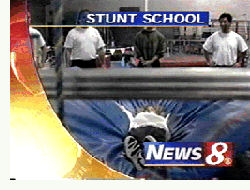 The ARIA Stunt School...
in it's normal format, is a very intensive weekend
workshop, with the opportunity to come back to "The Ranch" to do
workouts. It has been the most recognized program by the general
public, and news media world-wide. It was originally developed as an
introductory stunt class for "actors" wishing to have the skills needed
to do their own minor stunt work in roles where they would normally be
replaced by stunt performers during the execution of stunts. In many
cases, this makes the prospective actor that much more valuable in the
casting of the project, as only one person is needed to complete all
aspects of the role, instead of an actor/stunt person pair. As the
program progressed, so did the stunt performers, so additional training
was added as needed. Eventually high falls (to 10 stories) and fire
stunts became common for the classes. There were even units in Jerk
Line and Air Ram. At the time the program was suspended, it had worked
up to precision driving for stunt work in both automotive and marine
environments. Motorcycle stunts were always a part of the curriculum. The ARIA Stunt School...
in it's normal format, is a very intensive weekend
workshop, with the opportunity to come back to "The Ranch" to do
workouts. It has been the most recognized program by the general
public, and news media world-wide. It was originally developed as an
introductory stunt class for "actors" wishing to have the skills needed
to do their own minor stunt work in roles where they would normally be
replaced by stunt performers during the execution of stunts. In many
cases, this makes the prospective actor that much more valuable in the
casting of the project, as only one person is needed to complete all
aspects of the role, instead of an actor/stunt person pair. As the
program progressed, so did the stunt performers, so additional training
was added as needed. Eventually high falls (to 10 stories) and fire
stunts became common for the classes. There were even units in Jerk
Line and Air Ram. At the time the program was suspended, it had worked
up to precision driving for stunt work in both automotive and marine
environments. Motorcycle stunts were always a part of the curriculum.
|
How
To Get Started In The Motion Picture Industry...
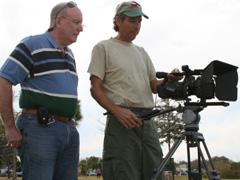
This
is a two hour short clinic (can be cut to one hour as a unit for a
larger day program or job fair), with about an hour worth of data
combined with an open question and answer session. These are given by
various members of the ARIA senior staff, and many times this
particular clinic is given by request to organizations or schools, free
of charge when crew has extra time. A full general picture of the movie
industry as a profession is given. This includes descriptions of the
various crew jobs, what training would be involved to fit into those
jobs - including actor training and avenues for experience. More often
than not, it is the question and answer period which does the most
benefit for all participants.
|
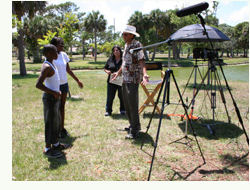 The
ARIA Film Lab For Youth...
was born during a need to train a few children for
roles
in a feature film in Orlando. From there the program expanded to an
enrollment platform of formal classes - these actually taught in a
specialized laboratory class environment (mock set) with twelve to
fifteen students. We have found, in over 20 years of production and
associated training experience, it is far easier to work with adults
right off the street, than it is to work with new children (who are
easily confused by the filming process when they have no prior
experience with it). This means the kids need to get some basic
training in to do well with the technology of filming. From there,
classes graduate to a real feature film setting, however, normally the
projects shot are written specifically for each class (roles written
for participants) and usually entail the shooting of a short film
subject. Crew requirements for the short film are actually filled by a
combination of students and their parents (parent participation is
voluntary). In this setting, parents receive free preliminary crew
training. It was the very last Youth class which spawned the feature
film: "Fallen". The
ARIA Film Lab For Youth...
was born during a need to train a few children for
roles
in a feature film in Orlando. From there the program expanded to an
enrollment platform of formal classes - these actually taught in a
specialized laboratory class environment (mock set) with twelve to
fifteen students. We have found, in over 20 years of production and
associated training experience, it is far easier to work with adults
right off the street, than it is to work with new children (who are
easily confused by the filming process when they have no prior
experience with it). This means the kids need to get some basic
training in to do well with the technology of filming. From there,
classes graduate to a real feature film setting, however, normally the
projects shot are written specifically for each class (roles written
for participants) and usually entail the shooting of a short film
subject. Crew requirements for the short film are actually filled by a
combination of students and their parents (parent participation is
voluntary). In this setting, parents receive free preliminary crew
training. It was the very last Youth class which spawned the feature
film: "Fallen". |
So What Is The Stunt World Really
Like?

This
is a short version of the weekend Stunt School modified for a general
audience, and devoid of aspects such as gun work, high-falls and fire
gags. There is a lecture followed by a question and answer period, and
then the group is exposed to the basics of screen fight techniques and
how they are used to "sell a shot" without causing injury to any of the
performers. This is where the hands-on starts to reveal how all of the
components of a shot come together to create the illusion of danger.
For many actors, this is as far as they need to go to get an edge on
casting in many action films not requiring more than hand to hand
fighting scenes. |
|



